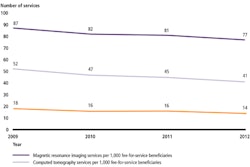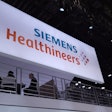It's coming: On January 1, 2012 -- less than three months from now -- all healthcare providers who bill for the technical component of advanced imaging services must be accredited under 2008's Medicare Improvements for Patients and Providers Act (MIPPA). But who are the accreditors? And what do they want from your imaging facility?
MIPPA's passage postponed a 10.6% increase in the sustainable growth rate (SGR) formula by 18 months. But it also included mandates designed to address the overutilization of advanced diagnostic imaging services by requiring providers to be accredited by January 2012 to receive Medicare reimbursement for the technical component of scans.
In January 2010, the U.S. Centers for Medicare and Medicaid Services (CMS) tapped three organizations as accrediting bodies for MIPPA: the American College of Radiology (ACR), the Intersocietal Accreditation Commission (IAC), and the Joint Commission. Each body offers its own version of accreditation.
American College of Radiology
The ACR's application process is electronic, according to Pam Wilcox, assistant executive director for quality and safety. Facilities go to the ACR's website and submit demographic, equipment, and personnel information; forms include a survey agreement, a HIPAA business associate agreement, modality forms, a personnel list, an equipment list, and application instructions and a checklist. There is no fee for this initial application.
The ACR then sends a testing package, for which the facility gathers and submits various clinical exams depending on modality as well as phantom images (in the case of CT, dose measurements are required). Facilities have 45 days to complete and return these testing packages to the ACR.
Currently, the ACR requires images to be submitted on film or CD, although the college plans to migrate to online submission early next year. Once received, a facility's clinical images are reviewed by radiologists from around country -- all of whom are in active practice -- and phantoms are reviewed by medical physicists. Once these audits have been performed and pass ACR criteria, the college lets the facility know that it has been accredited. From the time a facility submits its application, the accreditation process takes six months; from the time it submits its images, it takes less than 90 days, according to Wilcox.
Fees for the ACR accreditation process are by modality, with a base fee of $2,400 for CT, between $2,400 and $2,800 for MRI, and $1,200 each for PET and nuclear medicine, plus $600 per submodality. Facilities with three or more modalities (except mammography) get 10% off; practices with multiple sites also receive discounts.
The ACR is committed to doing everything within its control to assist sites with the accreditation process, but time is getting tight, Wilcox told AuntMinnie.com.
"Due to the limited amount of time remaining before January 1, 2012, we cannot guarantee that a site will complete the accreditation process before the MIPPA deadline," she said. "Review the testing instructions carefully. Double-check images and application materials to ensure they include all of the required images and data. Failure to follow instructions or an incomplete application will delay accreditation."
Intersocietal Accreditation Commission
The IAC provides imaging accreditation for five modalities -- nuclear medicine, MRI, CT, noninvasive vascular testing, and echocardiography -- via five divisions. Facilities begin the accreditation process through a link on the IAC's website, according to CEO Sandra Katanick.
With the IAC, the process begins when the facility reviews the standards and then completes the online application; uploads protocols, policies, and procedures; and copies cases to electronic media and sends them to the commission. The application is reviewed for completeness and forwarded to two clinical reviewers. Once those reviewers have made a recommendation, the IAC Division Board reviews the recommendation and makes an accreditation decision, which the IAC communicates to the facility. Length of time from submission to notification is approximately 45 to 75 days, depending on how complete the application is, Katanick said.
Fees for MRI and CT accreditation are $2,400 for the first unit and include one testing area; the IAC charges $400 per additional testing area and $1,200 per additional unit. For nuclear cardiology, nuclear medicine, and PET, the commission charges $3,300 for one area and $3,800 for a comprehensive accreditation that includes all cameras.
How does Medicare know that a facility is accredited? IAC submits information to Medicare weekly, according to Katanick. But facilities can help as well.
"We will contact and request all facilities that are in our online system to go back into their application and make sure their Medicare enrollment numbers and national physician identifier numbers are correct," she told AuntMinnie.com. "It's critical that those numbers be accurate in order to assure continuing reimbursement."
For facilities just getting started with the accreditation process, Katanick suggests first looking closely at the IAC website's resources, including webinars that will help make the process easier to understand and navigate.
"While we're unable to make any promises that a facility will be accredited by the January deadline at this point, we want our clients to know that our staff is taking steps to process applications as quickly as possible," Katanick said. "We understand that Medicare reimbursement is crucial to facilities' livelihood, and we want to help."
The Joint Commission
The Joint Commission conducts site visits, using patient care records in its accreditation process. Physician surveyors "follow" the route of three to four patients over a two-day, onsite survey. A facility may apply for an advanced diagnostic imaging (ADI) process for additional modalities as well, according to Michael Kulczycki, executive director for the ambulatory accreditation program. The ADI option is conducted by a physician surveyor, who can be a radiologist, and a specialist for that modality who evaluates the facility's infrastructure, oversight, supervision, and monitoring and quality control activities.
For a Joint Commission accreditation, a facility makes a deposit with its application, which is then credited to ensuing fees -- the total fees are spread across three years, with 60% due in year 1, 20% in year 2, and the final 20% in year 3. Single-site imaging center accreditation with the ADI option is about $10,940, although pricing is driven by patient volume, Kulczycki said.
The Joint Commission renders its decision approximately 10 days after a center has submitted any proofs of corrections, Kulczycki said. After it initially accredits a facility, the Joint Commission reviews the facility's annual self-assessment and performs an onsite survey every three years.
In August, the Joint Commission issued a sentinel alert on the dangers of medical radiation. While the alert does not translate into additional, specific requirements for MIPPA accreditation, Joint Commission surveyors will expect facilities to continually monitor sentinel alerts as they come out and address radiation risk areas in their practice, Kulczycki said.
The Joint Commission also has a webinar, originally posted in February, that facilities can access to learn more about beginning the accreditation process, Kulczycki said.
"We're still getting calls from organizations that are just getting started," he said. "We can still accommodate some with December surveys, but we can't guarantee final accreditation by the January deadline. But facilities should know that once they've submitted acceptable evidence of compliance [to accreditation standards], we typically render our decision in less than 10 days."




















